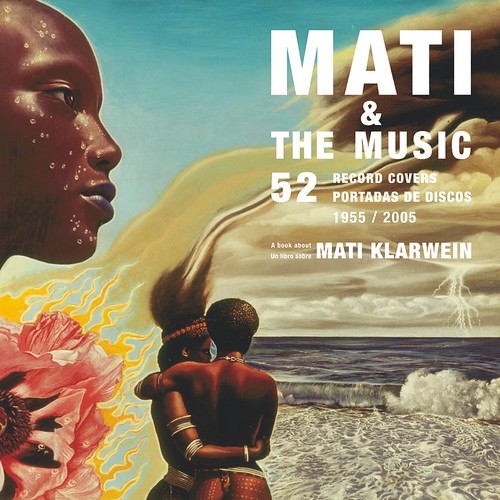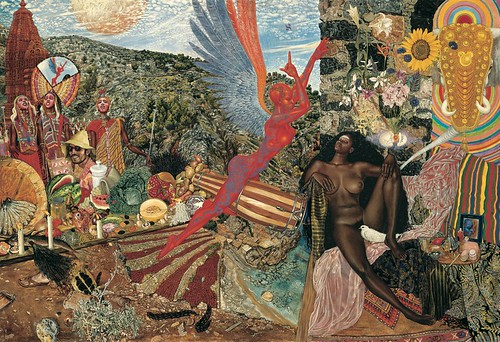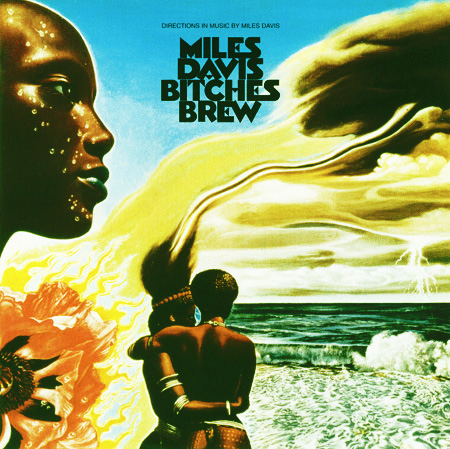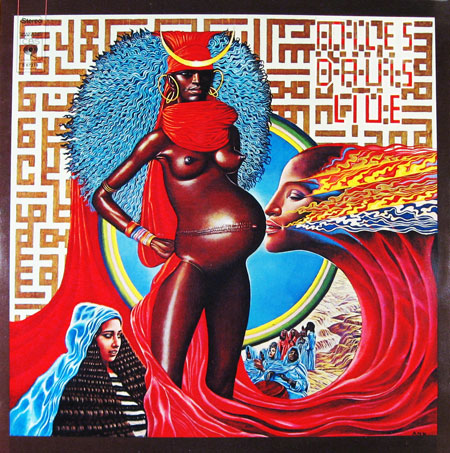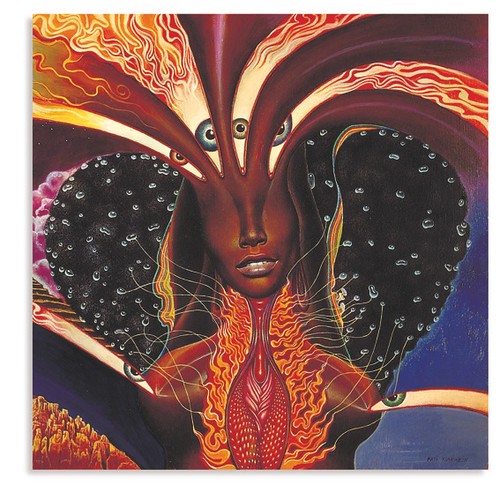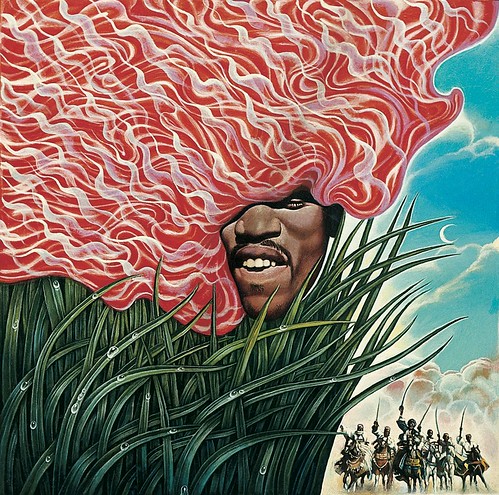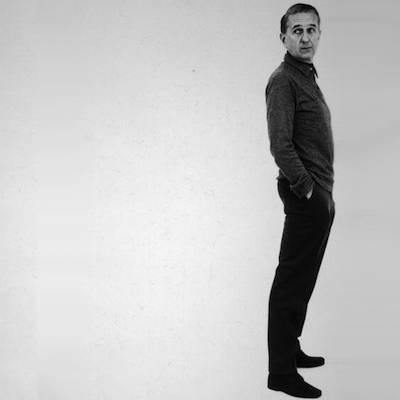Thursday, 9:46am
21 June 2012
Music, flesh and fantasy
When Mati Klarwein’s hyperactive paintings stole the psychedelic show.

Mati Klarwein is best known for a handful of album covers in the very early 1970s, a time when his exotic, erotically charged and quasi-mystical images stole the psychedelic show, writes John L. Walters.
Klarwein’s twelve-inch gatefold record sleeves could be seen plastered across music store walls and windows, on pristine penthouse hi-fis and in smoke-filled hippie squats. A new book, out this month (below), fleshes out the story.
German-born Klarwein (1932-2002) arrived in New York in the early 1960s and set about creating a huge series of artworks, including The Nativity, The Annunciation, The Tree of Life or Crucifixion and a three metre high wooden cube called The Aleph Sanctuary. (This was featured in Ginzburg and Lubalin’s Avant Garde no. 3, May 1968, credited to an anonymous artist and refered to as the ‘Alpha Sanctuary’.) Both Timothy Leary and Jimi Hendrix spent time in Klarwein’s box.
Klarwein was shrewd (or lucky) in his friends and clients. Carlos Santana’s Abraxas (top, which used part of Annunciation, above) was a multi-million-selling album. Other Klarwein covers include LPs by Reuben Wilson, The Last Poets, Buddy Miles, Osibisa, Malcolm X and Earth, Wind and Fire.
Miles Davis’s Bitches Brew (1970, above) didn’t have Abraxas’s sales figures, but it had controversy and credibility on its side. The sprawling, mysterious double album, along with its Klarwein-clad successor, Live Evil, changed the sound of jazz and helped catapult the careers of many Davis alumni, including Tony Williams, John McLaughlin, Joe Zawinul, Wayne Shorter, Chick Corea, Herbie Hancock and Keith Jarrett.
Below: portrait of Mati Klarwein by Bettina Rheims.
Like Davis, Klarwein (1932-2002) had an artistic sensibility and technical skills that had been honed in earlier times. He attended Bezalel Art Academy in Jerusalem and the Ecole des Beaux-Arts in Paris. He studied with Paul Colin and joined Fernand Léger’s studio. On the Côte d’Azur he learnt Flemish painting techniques from Ernst Fuchs. By the time psychedelia came along he’d been painting portraits and fantasies for a decade and a half, a virtuoso who had put in the requisite 10,000 hours.
You can see his technical mastery throughout this book, from wild fantasies to carefully crafted portraits (Leonard Bernstein, Buddy Miles); from fabulously detailed landscapes to queasily kitsch surrealism (the multibreasted figure of Tigermilk, 1986). The retrospective application of Klarwein’s art to music gave his hyperactive visual world a powerful cultural and commercial context.
As Dan Nadel points out in the new book Electrical Banana: Masters of Psychedelic Art, Klarwein was also a great designer, ‘in his ability to individualise each component of his dense canvases.’ Jazz fans may find that Klarwein’s mesmerising imagery immediately triggers a thrilling burst of electric Miles in their mind’s ear.
Above and below: paintings by Abdul Mati Klarwein. Design: John Berg.
There are later album covers, for George Duke, Jon Hassell (Maarifa Street, see this blog post by John Coulthart), and Ramon Farran & Robert Graves (his neighbours in the village of Deià in Majorca) and the Last Poets, that use similarly effective imagery. However some albums, such as Jam & Spoon’s Kaleidoscope, simply recycle (or sample) a Wales & Garcia cover, itself a detail of Saint Joan (1962).
But the CD format was never Klarwein’s friend. Mati & the Music is a heavy, completist, LP-sized coffee table book that includes an entertaining biographical essay (in French, Spanish and English) by Serge Bramly, who befriended the artist in the 1970s, alongside many fascinating photographs of the painter in action.
Mati & the Music: 52 record covers 1955-2005
Published by Editions 213 + RM, price £35, €38
LPs collected by Antoine de Beaupré; text: Serge Bramly.
See and read more about Klarwein’s full body of work at the online art gallery, matiklarweinart.com. John Coulthart wrote that, ‘Klarwein is one of the few 20th century artists to have taken Salvador Dalí’s photo-realist painting style and make of it something unique to himself.’ (‘The art of Mati Klarwein’, Feuilleton, Nov 2008.)
A limited (500) numbered edition of Mati & the Music includes a double vinyl LP: Miles Davis Live in Copenhagen, 1969, price €290 from galerie213.com and Colette. (The accompanying album cover uses Zonked, above, an image commissioned by Davis in the late 1960s for an album by Betty Davis but not used at the time. It was later used for a Last Poets album).
Electrical Banana: Masters of Psychedelic Art (PictureBox / Damiani) by Norman Hathaway and Dan Nadel will be reviewed in Eye 83.
For music lovers, one of the most tantalising elements in both books is a Klarwein cover (above) commissioned for a proposed collaboration between Jimi Hendrix and arranger Gil Evans (below). The guitarist died before the two legends could meet to discuss it.
Eye is the world’s most beautiful and collectable graphic design journal, published quarterly for professional designers, students and anyone interested in critical, informed writing about graphic design and visual culture. It’s available from all good design bookshops and online at the Eye shop, where you can buy subscriptions and single issues. Eye 82 is out now, and you can browse a visual sampler at Eye before you buy on Issuu. Eye 83 will be on press next week.

